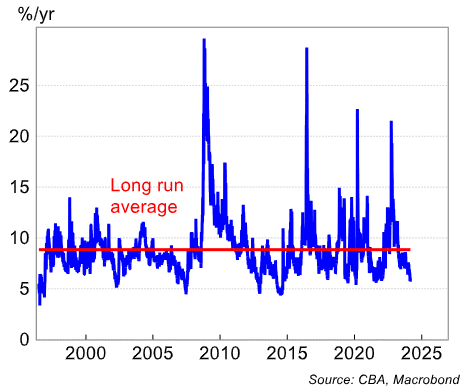Exchange Rate Markets Are "Strangled", But it Won't Last Says Soc Gen
- Written by: Gary Howes
-

Image © Adobe Images
Why exchange rate volatility is so low, and why it won't last long.
Foreign exchange rates are showing remarkable calm at the present time as volatility levels plummet; this week, we report that volatility in the Pound is now close to thirty-year lows.
Kit Juckes, head of foreign exchange research at Société Générale says these stable market conditions owe themselves to central bank policy expectations, but he also has a warning: it won't last.
The decline in volatility comes as the U.S. economy performs "much better than anyone expected, and the German economy, notably, has been doing badly," he explains.
As such, the U.S. rates market, which was pricing in six rate cuts for 2024, is now only pricing in three now.
"And yet, the Dollar Index is currently trading almost exactly at the average level of the last year, in the middle of a 100-107 range," says Juckes.
Above: GBP/USD implied volatility, one month at the money. Image: CBA.
He notes that between early January and mid-February, the dollar gained 4%, but only after falling by 6% in November/December.
"Why isn’t the exceptional performance of the US economy delivering more dollar strength?" he queries.
"Part of the answer is that the dollar was very strong before the fall at the end of last year, and it takes a lot of very good news to give it even a small lift higher. Another reason, which we have alluded to before, is that currencies are currently very sensitive to short-term interest rate trends, and while U.S. rate expectations have moved a fair bit, so have European ones," he explains.
At the start of this year, the rates market was pricing 7bp more in ECB cuts than Fed cuts this year (a total of 359bp for the ECB). Juckes notes that the gap is now 8bp, down to a total of 90bp of cuts.
"In other words, we have repriced ECB expectations by as much as we have repriced Fed ones, despite the US economy delivering strong data and Germany delivering weak data," he says.
The same dynamics are in play for the UK, Bank of England and the British Pound: 2024 has seen market expectations for Bank of England interest rate cuts decline in tandem with those of the Federal Reserve.
The above observation from ING Bank shows that interest rate expectations in Canada are also tracking those of the U.S., resulting in the steady trading patterns seen in the Canadian Dollar exchange rate complex.
"We have seen the market scale back its expectations for rate cuts this year," says James Knightley, Chief International Economist at ING. "We believe this is more a reflection of the global repricing of interest rate moves with the Federal Reserve expected to be far more cautious on policy easing, rather than a meaningful re-evaluation of the prospects for the Canadian economy."
Juckes says we have seen a lengthy period during which trends in yields have been highly correlated – "2-year Schatz yields are tracking 2-yr Treasuries to an unprecedented degree".
Image courtesy of Société Générale.
The chart above shows a rolling 104-week correlation between the two.
"The foreign exchange market thrives on differences – in growth, balance of payments, politics, inflation but most of all, monetary policy. Although there is reason enough for the ECB to let the Federal Reserve go its own way, that simply isn’t happening and the upshot is a weak, but steady euro, a strong but steady dollar," says Juckes.
In short, the market is betting other central banks will only move to cut rates once the Federal Reserve does so. This makes sense as these central banks don't want to risk a currency decline that would boost imported inflation.
Looking ahead, this calm "won’t last" he warns. "As the chart shows – central bank policy is highly correlated as we fight a global inflation threat, but economic divergence is going on in the background."


